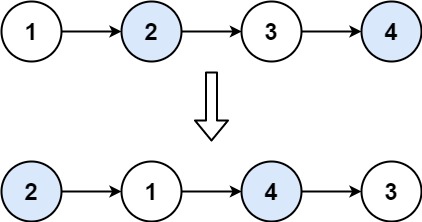[24. 两两交换链表中的节点](https://leetcode.cn/problems/swap-nodes-in-pairs/)
给你一个链表,两两交换其中相邻的节点,并返回交换后链表的头节点。你必须在不修改节点内部的值的情况下完成本题(即,只能进行节点交换)。
**示例 1:**

**输入:**head = [1,2,3,4]
**输出:**[2,1,4,3]
**示例 2:**
**输入:**head = []
**输出:**[]
**示例 3:**
**输入:**head = [1]
**输出:**[1]
代码:
/**
* Definition for singly-linked list.
* public class ListNode {
* int val;
* ListNode next;
* ListNode() {}
* ListNode(int val) { this.val = val; }
* ListNode(int val, ListNode next) { this.val = val; this.next = next; }
* }
*/
class Solution {
public ListNode swapPairs(ListNode head) {
ListNode dumyhead = new ListNode(-1); // 设置一个虚拟头结点
dumyhead.next = head; // 将虚拟头结点指向head,这样方便后面做删除操作
ListNode cur = dumyhead;
ListNode temp; // 临时节点,保存两个节点后面的节点
ListNode firstnode; // 临时节点,保存两个节点之中的第一个节点
ListNode secondnode; // 临时节点,保存两个节点之中的第二个节点
while (cur.next != null && cur.next.next != null) {
temp = cur.next.next.next;
firstnode = cur.next;
secondnode = cur.next.next;
cur.next = secondnode; // 步骤一
secondnode.next = firstnode; // 步骤二
firstnode.next = temp; // 步骤三
cur = firstnode; // cur移动,准备下一轮交换
}
return dumyhead.next;
}
}
[19. 删除链表的倒数第 N 个结点](https://leetcode.cn/problems/remove-nth-node-from-end-of-list/)
给你一个链表,删除链表的倒数第 `n` 个结点,并且返回链表的头结点。
**示例 1:**

**输入:**head = [1,2,3,4,5], n = 2
**输出:**[1,2,3,5]
**示例 2:**
**输入:**head = [1], n = 1
**输出:**[]
**示例 3:**
**输入:**head = [1,2], n = 1
**输出:**[1]
代码:
/**
* Definition for singly-linked list.
* public class ListNode {
* int val;
* ListNode next;
* ListNode() {}
* ListNode(int val) { this.val = val; }
* ListNode(int val, ListNode next) { this.val = val; this.next = next; }
* }
*/
class Solution {
public ListNode removeNthFromEnd(ListNode head, int n){
ListNode dummyNode = new ListNode(0);
dummyNode.next = head;
ListNode fastIndex = dummyNode;
ListNode slowIndex = dummyNode;
// 只要快慢指针相差 n 个结点即可
for (int i = 0; i < n ; i++){
fastIndex = fastIndex.next;
}
while (fastIndex != null){
fastIndex = fastIndex.next;
slowIndex = slowIndex.next;
}
slowIndex.next = slowIndex.next.next;
return dummyNode.next;
}
}
### 面试题 02.07. 链表相交
/**
* Definition for singly-linked list.
* public class ListNode {
* int val;
* ListNode next;
* ListNode(int x) {
* val = x;
* next = null;
* }
* }
*/
public class Solution {
public ListNode getIntersectionNode(ListNode headA, ListNode headB) {
// p1 指向 A 链表头结点,p2 指向 B 链表头结点
ListNode p1 = headA, p2 = headB;
while (p1 != p2) {
// p1 走一步,如果走到 A 链表末尾,转到 B 链表
if (p1 == null) p1 = headB;
else p1 = p1.next;
// p2 走一步,如果走到 B 链表末尾,转到 A 链表
if (p2 == null) p2 = headA;
else p2 = p2.next;
}
return p1;
}
}
### 142.环形链表II
/**
* Definition for singly-linked list.
* class ListNode {
* int val;
* ListNode next;
* ListNode(int x) {
* val = x;
* next = null;
* }
* }
*/
public class Solution {
public ListNode detectCycle(ListNode head) {
ListNode slow = head;
ListNode fast = head;
while (fast != null && fast.next != null) {
slow = slow.next;
fast = fast.next.next;
if (slow == fast) {// 有环
ListNode index1 = fast;
ListNode index2 = head;
// 两个指针,从头结点和相遇结点,各走一步,直到相遇,相遇点即为环入口
while (index1 != index2) {
index1 = index1.next;
index2 = index2.next;
}
return index1;
}
}
return null;
}
}





















 2902
2902

 被折叠的 条评论
为什么被折叠?
被折叠的 条评论
为什么被折叠?








